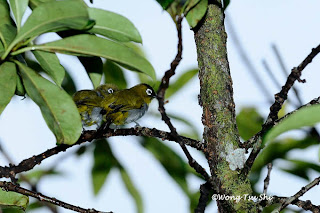Edited on 30 March 2018 text with green background.
6.00 am on 30th August saw us arrived at Power Station, a lot of activities were seen happening there at the wee hour. First, we were greeted by the Bornean Whistling Thrush Myophonus borneensis, formerly Sunda Whistling Thrush Myophonus glaucinus (split by Collar 2005), which was busy feeding on moths and insects on the ground.
6.00 am on 30th August saw us arrived at Power Station, a lot of activities were seen happening there at the wee hour. First, we were greeted by the Bornean Whistling Thrush Myophonus borneensis, formerly Sunda Whistling Thrush Myophonus glaucinus (split by Collar 2005), which was busy feeding on moths and insects on the ground.
Bornean Whistling Thrush
Fruits and insects brought along Golden-naped Barbet Megalaima pulcherrima (now Psilopogon pulcherrimus), Indigo Flycatcher Eumyias indigo, Short-tailed Green Magpie Cissa thalassina (now Borneo Green Magpie Cissa jefferyi), Bar-winged Flycatchershrike Hemipus picatus, Mountain Black-eye Chlorocharis emiliae (now Zosterops emiliae), Temminck's Sunbird Aethopyga temminckii, Ashy Drongo Dicrurus leucophaeus, Bornean Treepie Dendrocitta cinerascens, White-browed Shrike-babbler Pteruthius flaviscapis (now Blyth's Shrike-vireo Pteruthius aeralatus), Sunda Bush-warbler Cettia vulcania (now Horonis vulcanius), Sunda Laughing-thrush Garrulax palliatus (now Sunda Laughingthrush Leucodioptron palliatum), White-breasted Woodswallow Artamus leucorhynchus, Pacific Swallow Hirundo tahitica and Swiftlets (looks like Glossy Swiftlet Collocalia esculenta (now Plume-toed Swiftlet Collocalia affinis)).
Golden-naped Barbet
Short-tailed Green Magpie
Mountain Black-eye
Temminck's Sunbird
Sunda Laughing-thrush
Went to have brunch at the Koporasi's Canteen across the road from KP head quarter, both their food and price were acceptable. Went to Liwagu trail immediately after brunch and was rewarded with a pair of Whitehead's Trogon Harpactes whiteheadi, the male bird would always perch on a branch that would never enable us to get an unblocked view for photograph. This is my second Whitehead's bird and what a delight to have them on the sensor of my camera. The other Whitehead's bird that I am after is the Whitehead's Spiderhunter Arachnothera juliae, which I am sure I will be rewarded if I try long and hard enough. Here are the Trogons;
Whitehead's Trogon male
Whitehead's Trogon Female.
Further along the trail we were greeted by the incessant singing of a small group of endemic Mountain Wren-babbler Napothera crassa (now Turdinus crassus), indeed another bonus for the trip.
Mountain Wren-babbler
The Bornean Whistler is also endemic to Borneo.
The Bornean Forktail Enicurus borneensis (Split by Moyle et al 2005), exist in rocky streams in Montane primary forests, where it replaces the very similar lowland White-crowned Forktail Enicurus leschenaulti (now Malayan Forktail Enicurus frontalis) . We waited for two hours for it to show and we were eventually rewarded when it showed up along the Liwagu River. Light level was not ideal inside the dark under-storey along the river, I was forced to use ISO 1600 for the shots, as flashing the feeding Forktail would guarantee its immediate departure.
Bornean Forktail
Bornean Forktail
Left Liwagu river after shooting the Bornean Forktail and to our delight we found that Mount Kinabalu, which was usually covered by low lying clouds in the afternoon, was clearly in view.
Mount Kinabalu
Mount Kinabalu
To be continued and happy birding.


















































